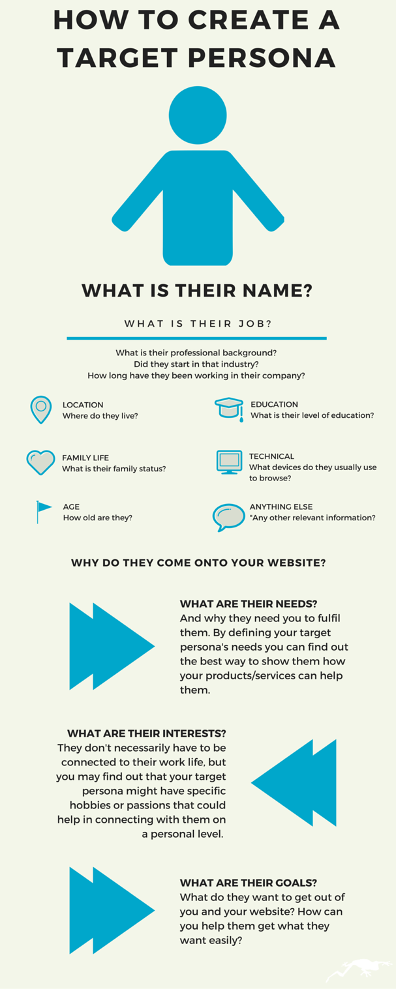The complete guide to buyer personas –Why, what and how to create them

You know your target audience, so why do you need to know what a business persona is and more importantly, why do you need to use one?
The short answer is that a business persona, often referred to as the buyer persona, will help you and your business understand your customers on a more intimate level. It’ll make customer acquisition and retention so much easier and as a result, you’re more likely to attract higher value customers and leads. A lot of people mistakenly think that because they know their target audience, they know how to market to their prospective customers. But very rarely does a company have a “one size fits all” when it comes to target audiences and even more rarely has a company dug deep enough to truly understand the customers within that target audience.
What are buyer personas?
In very simple terms, a buyer persona is a representation of your target audience that has been segmented into specific groups. As mentioned in the introduction, it isn’t enough to just define a target audience, it’s important to divide them into groups based on key factors that are relevant to your services or your products. Those groups may be demographical, or professional, interest-related, sector-driven, and so on. It’s important to recognise what makes these groups separate from each other and how they want to be communicated to, and this group is what forms your persona.
For example, inside your target audience you may have a group of health and safety managers in manufacturing companies and another group of procurement professionals in building contractors. Even though these two figures - or personas - may end up buying the same product or service from you, they will have very distinct responsibilities in their day-to-day life. They will be looking at different benefits of your offering and will resonate with different approaches. That is why by distinguishing between them and segmenting your communication and approach accordingly, you can make your marketing and sales communication resonate more and in turn have more sales and grow your business.
Why do you need buyer personas?
Mass-marketing and generalised, bland messages that intend to capture the attention of everyone, will end up resonating with no one. Automation software today allows us to tailor communication right down to the individual, serving it to them at the right time and in the right way, but this is not achievable if you don’t know who these individuals are. You need to start understanding the collective thinking of the groups of people you are trying to target, because the way the group thinks, is the way you need to think. The way they speak is how you need to speak. The content they read is where you need to write. It also helps you understand how to position your product or service in a way that will help them buy it.
If you can personalise your marketing and selling so that you are talking to the exact person you want to talk to about their problems, their interests and their goals, and in a way they want to be talked to, your power of attracting them and turning them into customers is much greater and your voice will rise above the crowd. To give you an example, you wouldn’t walk into a pub and tell everyone there about yourself. You would go in and ask them about themselves first, adapt what you know, your stories and experiences so it applies to their world, so that you can find some common ground and keep the conversation going. But that would be impossible without knowing who they are, and in marketing that is exactly what defining your personas allows you to do.
Common Persona Myths
So far it seems like a no-brainer, right? I and most marketing professionals around the world think so too, but we at Purple Frog still come across some objections when we bring up the topic of personas, which can be easily addressed by understanding a couple of things.
I don’t have a persona; it varies by each organisation
A lot of people confuse the term persona with the job role of a person in an organisation. Whilst job roles often make it easier to group your target audience together, it doesn’t always work that way. Sometimes a persona is a group of people who all buy in a certain way or have a shared issue or goal. So if they don’t all conform to the same job title or even department in an organisation, it doesn’t mean that you don’t have a persona, it’s just that you have consider other ways in which they’re connected rather than job role.
What if I just want to target a sector/vertical rather than a person?
You will always do business with people, not a company. It is a person who will research an issue they are having and find you, who will reply to your emails, attend meetings, and ultimately sign the contract/purchase the item. What identifying the persona allows you to do is to connect with that person on the level that they would respond to the best, changing your narrative to resonate with them and their world.
Our persona varies based on the product/service we are selling
Great, that means you already have the basis for developing multiple personas! The typical business will have 5-25 personas they are targeting, with some large corporates going more towards 50-100. The secret is not to create a persona for everything you do, that would be no different than having one target audience, but it’s about segmenting these, even by individual product/service you offer if necessary.
We interact with different people at different stages of a sale
This is of course incredibly common, and that is why it is important to define each type of person you interact with as a different persona, and then create content and change the way you talk about your products and services based on each one of them. In a typical sale journey for instance there is often a researcher, an influencer, a financial/admin person, and a decision-maker. Tailoring your messaging around what each one of these figures will ensure you give them all the tools they need to convince themselves to buy from you.
How to get started
Get the team involved
Our persona projects always start with doing a workshop involving the whole team, from the senior leaders to the on-the-ground people, from sales to operations. Everyone will have their own experience of the persona and see different angles to others. Having a meeting where you flesh out all that you know about this group of people and making sure to record all the different opinions and perceptions is a great starting point.
Ask your customers
If you just rely on your team’s internal perceptions, you may be basing your whole marketing strategy on too many assumptions. That is why we always insist with our clients to give us the contact details of their customers so we may ask them a few questions to validate some of the theories that have come up. If you can find a representative of your persona in real life and get them to answer questions, you are one huge step closer to really getting under the skin of your persona and attracting more like that. And the answers we get from customers VS the business’ internal team are often very surprising and completely change the direction of the campaigns, so we would advise never to miss this step out. There are two main ways to research your personas.
1-to-1:
If you want to know what your customers’ challenges, goals and interests are, ask them!
In person results are more accurate, they allow us to speak to the person either face-to-face or over the phone and leaves less room for people to select random answers just for the sake of filling in a survey. You also get a lot more in-depth, and it is not unheard of for us to call up someone for a 5-minute chat, and for it to turn into 40-minute insightful conversation! People are generally willing to share, especially when it comes to unloading their challenges or giving feedback on a company, especially if this is done effortlessly in a conversation. We typically recommend conducting at least 4-6 of these conversation per persona.
Online:
If you also want more quantity in your responses, or you really cannot speak 1-to-1 with customers, you can turn to online surveys.
There are many tools that one can use; SurveyMonkey and Google Forms are among the two most common. HubSpot Service Hub also allows you to create these surveys and record them directly into your CRM.
Carefully choose your questions to give you the most value, and pre-test the survey among your colleagues or a small section of the target audience to check you are getting the right answers you are looking for, before submitting it to everyone else. Consider offering an incentive for their cooperation, as most people will ignore your request claiming that they are “too busy”.
Create your persona
There are online tools that can help you, such as the Make my Persona website by HubSpot. Below is also an infographic we put together to guide you through what to include around the persona.

Test your hypothesis
It is impossible to get everything right all the time, so what you need to do is work out how to experiment, and experiment well. You need to find out if what you do and the way you talk about it, is correct, and the easiest, most straightforward way of doing that is to just ask them. And what I mean by that is not to ask them: “Will you buy my product/service?” but instead ask “Why won't you buy my product/service?” This way you'll get real insights into their thinking and an understanding into the barriers you need to remove to find true success in reaching that group of people or persona. You'll be able to to address their concerns as well as the opportunity to innovate and match or exceed what the market is actually looking for.
Once you get collate this feedback, you can apply your newfound knowledge by tweaking the messaging that you've created. You can adjust the thinking that got you where you were when you started, thus adding value. You're standing out from the crowd of your competitors, and you aren't merely doing marketing to sell, you're doing marketing to learn and improve. Because the true art of marketing is not about pushing a message onto someone, it is about empathy and understanding. It's allowing somebody to make their own mind up.
Analyse and change
I always see people do experiments and learning things but failing to actually sit and analyse these findings. They should be asking themselves “what is it that I’ve discovered?”, “What is the new, fresh insight to me about my personas?” And “how can I feed that information better into everything I do to improve the ability to help our customers buy?”
Marketing often is about understanding what doesn’t work as well as what does, and that sometimes means understanding who doesn't want to buy your products or services. If you push the wrong people, they will block you.
On many occasions, my team at Purple Frog have found that the persona originally identified by our clients isn’t actually the best persona to target. A classic example of this, is when businesses tell us their main persona is CEOs, but then fail to realise that whilst the CEO might sign on the dotted line at the end, it’s not them who do the research and selects the suppliers and does all the hard work before ultimately bringing it to the CEO to sign-off. Failing in attracting the attention of the people who do the work before the CEO signs and getting a conversation started with them, would rule you out of the running before you even start.
So, it is important to think critically about these experiments and findings, and go back to the drawing board if needed, crossing out the personas that aren’t working and adding new ones.
Conclusion
It’s important to create your buyer persona to understand your target audience on a deeper level. Understanding what makes them tick, where they research online, what they do before they get to work, all helps you qualify and market to your personas on such a level, they won’t be able to resist your offerings. Make sure that everyone in your team knows best how to work with and more importantly, support your customers. Then sit back and watch as your customer acquisition and retention improve.
More from Inbound Marketing

What Marketing and Sales Can Learn From The State of Inbound 2016 [FREE REPORT]
Find out what's next in the world of sales and marketing and make sure you are meeting your potential buyers' needs! The State...
5 Great Call-to-Action Examples That We Just Couldn't Ignore!
It may seem obvious but surely the purpose of a Call-to-Action (CTA) should be to grab your attention and shout "CLICK ME!"?...






